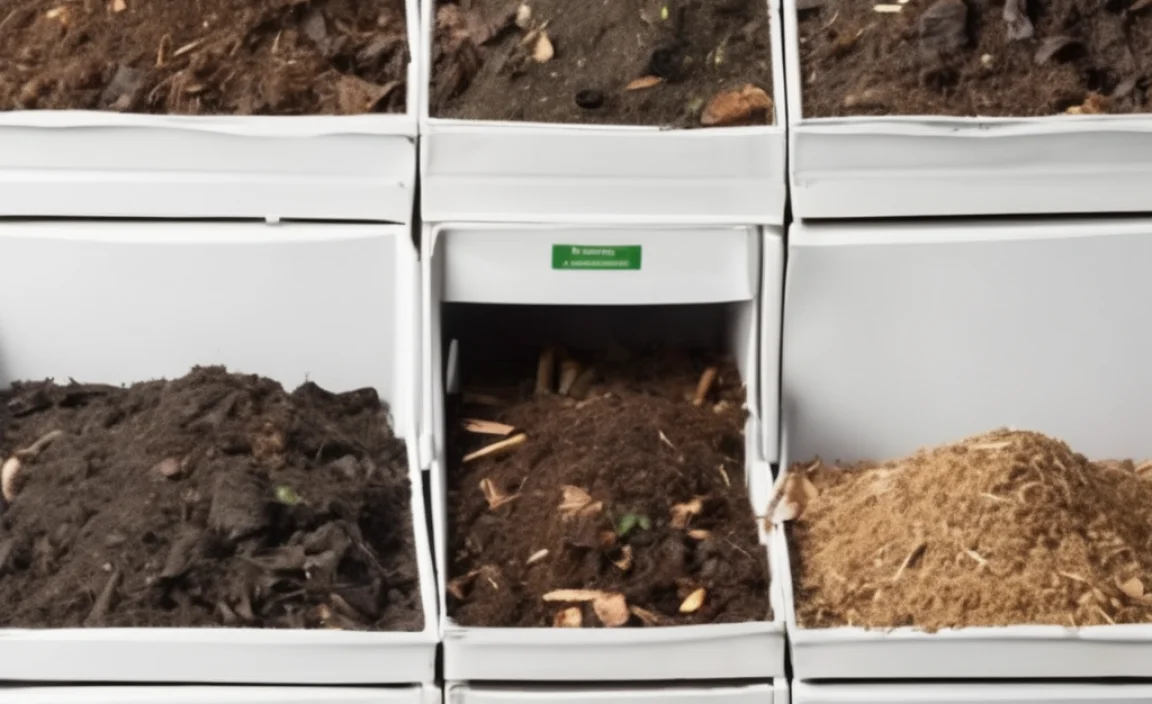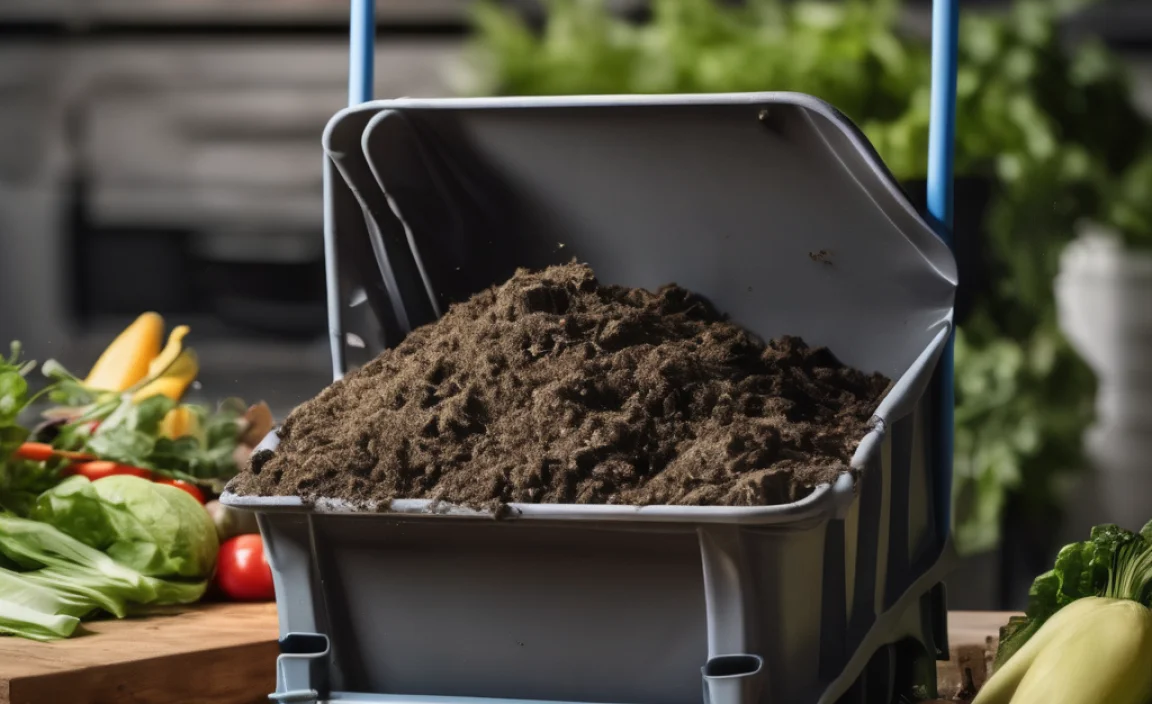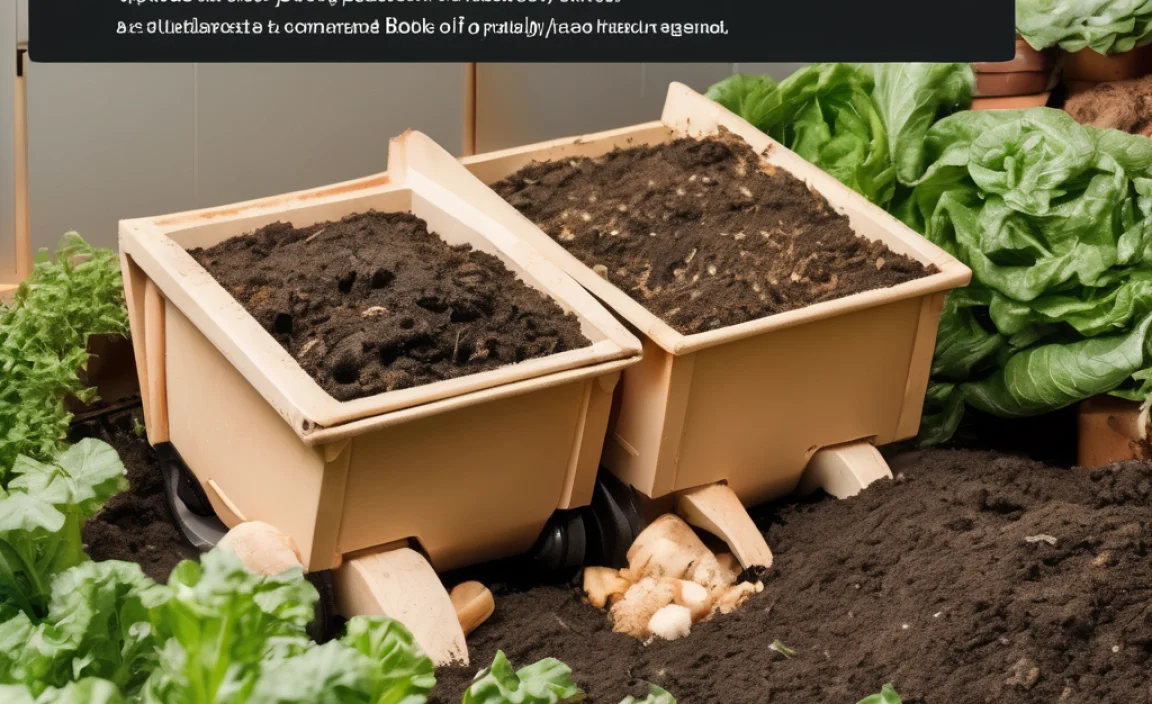Thinking about starting a composting business? That’s fantastic! Turning waste into valuable compost is a smart move for the planet and potentially your wallet. But like any new venture, there can be a few bumps in the road. Sometimes, those little hiccups can feel like big problems, right? Don’t worry, we’ve all been there. This guide is all about spotting those common composting business mistakes early and, more importantly, fixing them. We’ll walk through it step-by-step, just like a neighbor showing you how to get your garden growing. Stick around, and we’ll help you build a successful composting business on solid ground!
The Top Composting Business Mistakes & How to Easily Fix Them

Starting a composting business is an exciting venture into sustainable practices. It’s rewarding work, and with careful planning, it can be very profitable. However, many new composting businesses make similar mistakes that can hinder their growth or even cause them to fail. My goal here is to help you avoid these common pitfalls. Think of this as a friendly chat, sharing what I’ve learned so you can build a thriving, efficient, and successful composting operation. We’ll break down the issues and give you clear, actionable solutions.
Mistake 1: Not Doing Your Homework on the Market
This is a big one! Many folks jump into composting without really understanding who will buy their finished compost or what they need. Are you targeting home gardeners, landscapers, farms, or maybe even nurseries? Each group has different quality expectations and often different quantities they’re willing to purchase. Pricing is also key. You need to know what competitors are charging and what price point makes sense for your costs and profit goals.
The Fix: Research, Research, Research!
- Identify Your Target Customer: Who are you selling to? Spend time talking to potential buyers. Ask them what they look for in compost (e.g., texture, nutrient content, weed-free) and how much they typically buy.
- Analyze the Competition: Look at other composting businesses in your area. What are they offering? What are their prices? This will help you find your niche and position yourself effectively. Organizations like the US Composting Council offer resources that can guide your market research.
- Understand Demand: Is there a higher demand for bagged compost for homeowners, or bulk compost for commercial clients? This will influence your packaging, delivery, and marketing strategies.
Mistake 2: Underestimating the Cost of Operations
It’s easy to get excited about the composting process itself and overlook the true costs involved. Think beyond just the bins or piles. You have to factor in labor, transportation (collecting feedstock and delivering compost), equipment maintenance, marketing, insurance, permits, and managing potential odors or pests. These operational expenses can add up surprisingly fast.
The Fix: Create a Realistic Budget
Sit down and map out every single potential cost. It’s better to overestimate than underestimate.
- List All Expenses: Create a detailed spreadsheet. Include startup costs (equipment, land, permits) and ongoing operational costs (labor, fuel, utilities, insurance, marketing, supplies).
- Factor in the Unexpected: Always set aside a contingency fund (about 15-20%) for unforeseen expenses. Even the best plans can encounter surprises.
- Track Your Time: If you’re doing much of the work yourself, don’t forget to value your time. This helps in pricing your compost appropriately and recognizing when you might need to hire help.
Mistake 3: Poor Feedstock Management
Your compost quality directly depends on what you put into it! Collecting the wrong materials, having inconsistent feedstock, or not blending your greens and browns correctly can lead to smelly, soggy piles or slow decomposition. This can frustrate you and, more importantly, create a low-quality product that nobody wants.
The Fix: Establish Strict Input Guidelines
Control is key here. You need a system for what comes in and how it’s processed.
- Develop Clear Acceptable Materials Lists: For both commercial and residential sources, create a list of what you can accept and what you cannot. Educate your feedstock suppliers clearly and repeatedly.
- Inspect Incoming Materials: Have a process for screening materials as they arrive. Remove contaminants like plastic, glass, or problematic metals.
- Master the Green-to-Brown Ratio: Learn the ideal ratio for efficient composting (generally around 1 part green to 2-3 parts brown by volume). You might need to source different types of materials to achieve this balance. Tools like the EPA’s composting guide can offer insights into material ratios and composting science.
Mistake 4: Ignoring Regulations and Permits
This is a common oversight for many new entrepreneurs, but it can lead to significant fines or even shutdown. Composting operations, especially those dealing with commercial waste or operating at a certain scale, are often subject to local, state, and sometimes federal regulations. These cover things like odor control, water runoff, site management, and the types of materials you can process.
The Fix: Be Proactive with Compliance
Don’t wait to be told you’re doing something wrong. Do your homework upfront.
- Contact Local Authorities: Reach out to your city, county, and state environmental protection or waste management departments. Ask about licensing, permits, and any zoning requirements for composting facilities.
- Understand Environmental Safeguards: Learn about best practices for managing leachate (liquid runoff), controlling odors, and preventing pest issues. Many regulatory bodies provide guidelines on these topics.
- Stay Updated: Regulations can change. Make it a habit to check in with relevant agencies periodically to ensure you remain compliant.
Mistake 5: Inefficient Site and Process Design
Where you set up your composting operation and how you manage the piles or bins makes a huge difference in efficiency and effectiveness. A poorly designed site can lead to wasted labor, slow composting, and management headaches. Think about how materials flow from arrival to processing to curing and finally to dispatch.
The Fix: Plan Your Layout and Processes Logically
A little planning goes a long way in making your operation run smoothly.
- Site Layout: Designate specific areas for receiving feedstock, active composting, curing compost, finished product storage, equipment parking, and office/storage space. Ensure good access for vehicles.
- Process Methods: Will you use windrows, aerated static piles, or another method? Choose a method that suits your scale, climate, and available resources, and stick to best practices for that method. Methods like forced aeration in static piles can significantly speed up composting and reduce odors.
- Water Management: Plan for how you’ll manage moisture in your piles and how to manage rainwater runoff from your site to prevent pollution.
Mistake 6: Poor Quality Control of Finished Compost
Your reputation is built on the quality of your compost. Selling inconsistent, immature, or contaminated compost will quickly drive customers away. This means finished compost that still has recognizable food scraps, weed seeds, or an unpleasant odor.
The Fix: Implement a Robust Quality Assurance Program
Treat your compost like a premium product, because it is!
- Monitor Temperature: Regularly check the temperature of your compost piles. High temperatures (131°F to 160°F or 55°C to 71°C) are crucial for killing weed seeds and pathogens. This is a key indicator of biological activity.
- Check for Maturity: Compost is ready when it’s dark, crumbly, smells earthy, and the original materials are no longer recognizable. You can also perform simple tests like planting seeds in it to check for phytotoxicity (plant toxicity).
- Screening: Use a screen to remove any large, uncomposted material, leaving you with a uniform, fine product that’s desirable to customers.
- Consider Lab Testing: For commercial clients or specialized markets, periodic lab analysis of nutrient content and contaminants can be a valuable selling point.
Mistake 7: Inadequate Marketing and Sales Strategy
You can make the best compost in the world, but if no one knows about it, you won’t sell any. Many composting businesses fail to effectively market their product or build strong customer relationships. Simply having a website and hoping people find you isn’t enough.
The Fix: Actively Promote and Sell Your Compost
Think like a business selling any other product. You need to get the word out!
- Build an Online Presence: Have a professional website and active social media profiles. Share photos of your process, testimonials, and tips on how to use compost.
- Network Locally: Attend farmers’ markets, gardening shows, and local business events. Connect with garden centers, landscapers, and community gardens.
- Offer Samples and Testimonials: Let potential customers try your product. Encourage happy customers to share their experiences.
- Develop Different Product Offerings: Consider bagged compost for retail, bulk delivery for larger clients, and maybe even custom blends. This Sustainable Agriculture Research and Education (SARE) resource offers great insights into business planning for agricultural ventures, including marketing.
Mistake 8: Not Having a Plan for Odor and Pest Control
Composting, if not managed correctly, can attract pests like rodents and flies, and can produce unpleasant odors. This is often a major concern for people living or working near a composting site and is a common reason for complaints or regulatory issues. It can quickly give your business a bad name in the community.
The Fix: Implement Proactive Management Strategies
Keeping your compost healthy and contained is key to being a good neighbor and a reputable business.
- Maintain Proper Aeration: Good airflow is crucial. Ensure your piles/windrows are not too wet and are adequately turned or aerated. This helps prevent anaerobic conditions, which cause foul odors.
- Manage Moisture Levels: Compost should be moist like a wrung-out sponge, not waterlogged. Adjust watering or add more carbon materials (browns) if it’s too wet.
- Cover Actively Composting Piles: In some cases, covering your active piles with a layer of finished compost or a breathable fabric can help contain odors and deter pests.
- Proper Site Location: If possible, choose a location that is a reasonable distance from residential areas.
- Regular Pest Monitoring: Keep an eye out for signs of pests like rodents or flies and take prompt action if they appear.
Mistake 9: Scaling Up Too Quickly or Too Slowly
This is a balancing act. Scaling up too quickly without proper planning, infrastructure, or customer base can leave you overwhelmed and financially strained. On the other hand, being too slow to scale might mean missing out on market opportunities and allowing competitors to gain an advantage.
The Fix: Strategic and Phased Growth
Growth should be steady and managed. Plan your expansion carefully.
- Grow Based on Demand: Don’t invest in new, large equipment or expanding your facility until you have a solid, growing customer base and predictable sales.
- Phased Investment: Break down your expansion into manageable phases. For example, first invest in better feedstock screening, then perhaps an additional turning machine, and so on, as your revenue grows.
- Financial Planning: Secure adequate funding for expansion. Understand your cash flow and ensure you can cover increased operational costs during growth periods.
- Continuous Improvement: Even as you scale, always look for ways to improve efficiency and product quality.
Mistake 10: Lack of Insurance
This is a critical oversight that many small businesses make. Operating any business, especially one involving physical processes and machinery, carries inherent risks. A composting operation can face risks from accidents, equipment damage, environmental incidents, or product liability. Without proper insurance, a single incident could be financially devastating.
The Fix: Secure Comprehensive Business Insurance
Protect your investment and your future with the right coverage.
- General Liability Insurance: This covers common business risks like customer slip-and-fall incidents or property damage.
- Product Liability Insurance: Essential for compost businesses, this covers claims if your compost caused damage to customers’ plants or property.
- Commercial Auto Insurance: If you use vehicles for business, you’ll need this.
- Workers’ Compensation: If you have employees, this is likely mandatory and covers their medical expenses and lost wages if they get injured on the job.
- Consult an Insurance Broker: Talk to a broker who specializes in business insurance, particularly for agricultural or waste management operations. They can help you understand specific risks and find the right policies. The Small Business Administration (SBA) website offers excellent, free resources on business insurance.
Understanding Your Composting Business Expenses

Knowing where your money goes is vital for profitability. Here’s a look at common expenses you’ll encounter. Understanding these helps in budgeting and pricing.
| Expense Category | Typical Items | Importance for Growth |
|---|---|---|
| Startup Costs | Land purchase/lease, permits/licenses, initial equipment (shredder, turner, screen, truck), site preparation, initial marketing materials. | Foundation for operations. Underestimating can halt progress before it starts. |
| Operational Costs (Ongoing) | Labor wages, fuel, utilities (water, electricity), equipment maintenance & repairs, insurance premiums, marketing & advertising, office supplies, waste disposal (for contaminants). | Directly impacts profitability and ability to serve customers consistently. Efficiency here is key. |
| Feedstock Acquisition | Costs associated with collecting waste (transportation, tipping fees if any), processing/preparing incoming materials. | Affects cost of raw materials. Securing reliable, low-cost feedstock is a major advantage. |
| Sales & Distribution | Packaging (bags, bulk containers), delivery vehicle costs (maintenance, fuel), marketing collateral, sales commissions (if applicable). | Crucial for getting product to market and generating revenue. |
| Compliance & Legal | Permit renewal fees, legal consultation, environmental monitoring costs. | Avoids costly fines and shutdown. Ensures long-term viability. |
Common Composting Methods for Businesses

Choosing the right method impacts efficiency, cost, and quality. Here are a few you might consider:
- Windrows: Long, rectangular piles that are turned regularly with machinery. Great for larger volumes and good aeration, but require space and regular turning.
- Aerated Static Piles (ASP): Piles are built over a network of pipes through which air is either blown or drawn. This method significantly speeds up decomposition, reduces odors, and requires less physical turning. It is often more energy-intensive but can be very efficient for medium to large operations.
- In-Vessel Composting: Materials are composted inside containers, bins, or trommels. This offers excellent control over the composting environment, minimizing odors and pests, and producing high-quality compost quickly. It’s typically more expensive to set up but can be ideal for urban areas or where space is limited.
- Composting with Worms (Vermicomposting): While often associated with smaller scales, large-scale vermicomposting operations exist. Worms process organic matter efficiently, producing nutrient-rich castings. This method is good for specific waste streams like food scraps.
Frequently Asked Questions About Composting Business Mistakes
What is the biggest mistake new composting businesses make?
The biggest mistake is often underestimating the costs and complexity of operations. This includes not just equipment, but also labor, transportation, marketing, and regulatory compliance. Many also fail to thoroughly research their market and identify consistent, paying customers BEFORE they start.
How can I ensure my compost is high quality?
High-quality compost comes from managing your feedstock carefully (correct brown-to-green ratio, no contaminants) and properly monitoring the composting process. This means maintaining the right temperature, moisture, and aeration for sufficient periods to ensure complete decomposition and kill weed seeds and pathogens.
What are the most common regulations for composting businesses?
Regulations vary greatly by location, but commonly include permits for facility operation, site management plans (addressing odor, pests, and leachate), and rules about the types of materials you can accept. It’s crucial to contact your local and state environmental agencies early in your planning process.
Is it hard to manage odors and pests in a composting business?
It can be challenging but is manageable with proper practices. Key strategies include maintaining good aeration to prevent anaerobic conditions (which cause bad smells), managing moisture levels, and ensuring you’

I am passionate about home engineering. I specialize in designing, installing, and maintaining heating, ventilation, and air conditioning systems. My goal is to help people stay comfortable in their homes all year long.

